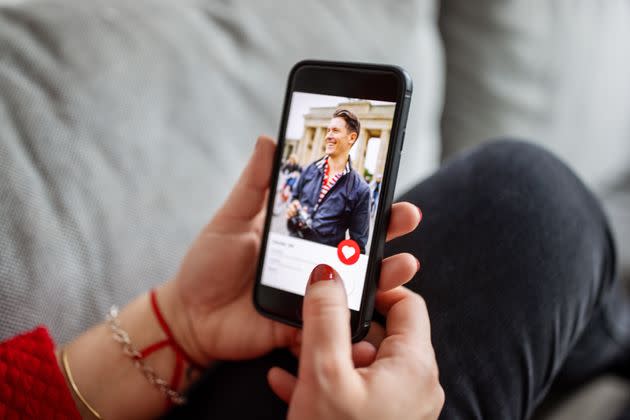How Men Judge A Dating Profile Versus How Women Do, According To Science

When you’re looking at someone’s dating profile, how long do you stare at their photos? Are you quick to read (and judge) the written portion of the profile? Do you pay close attention to what they’ve filled in under occupation? (“CEO at self-employed” and a graduate of the “school of hard knocks”? Let’s be honest, you’re splitting the tab or paying for dinner yourself.)
A new study published in Archives of Sexual Behavior earlier this summer suggests that where your attention goes first may depend on your gender.
Researchers monitored eye movement to see how straight men and straight women evaluated online dating profiles.
Generally speaking, men tended to zero in on physical attractiveness before taking anything else into account. (No surprise there, given the amount of studies that have shown that men are highly visual when it comes to picking a mate.)
Women, meanwhile, considered both attractiveness and resource potential.
“Regardless of how attractive the man was (high or low), women spent more time looking at men’s faces when resources were low than high,” said Amy Lykins, a lead author of the study and an associate professor in clinical psychology at the University of New England in New South Wales, Australia.
Though Lykins stressed that the findings are open to interpretation and didn’t offer one herself, one possible reading is that women on dating apps may throw less well-off men a bone by scrutinizing their attractiveness more closely. (He may not be pulling in six figures, but he’s got a cute face...)
Men were predominantly interested in women’s faces, with one interesting exception: They tended to spend a little extra time with the profile if the woman had a high-paying or prestigious job, especially when she was rated as less attractive. So essentially, women were more generous toward less-resourced men when they were attractive, while men were more generous toward less attractive women when they had more resources.
What was more important, a pretty face or a gym-sculpted body? The researchers found that both men and women clock the face first. A total of 83% of the gaze time was directed to the face region, regardless of the other information presented.
“We expected this,” Lykins told HuffPost. “I’ve found this in other eye-tracking studies I’ve conducted, even where people were barely clothed and/or even nude. People are extremely interested in faces ― even as newborns ― and that’s true for both men and women.”

Another difference that’s not entirely surprising? Overall, men reported greater interest in short-term relationships than long-term, and women reported greater interest in long-term relationships than short-term.
Lykins says there are some limitations of the study. For starters, none of the participants ― 20 men and 20 women ― identified as LGBTQ.
“It would be worth running a similar kind of study with LGBT participants to see if the patterns hold,” she said.
She’d also like to see research that looks at older people’s behavior, since all the participants in her study were university students between the ages of 18 and 27.
What was most interesting to Lykins about her findings was that they showed that when it comes to online dating, we’re all pretty much making snap judgments.
“We now have evidence that we can see these kinds of patterns even in the first 10 seconds of looking at dating profiles,” she said. “These judgements seem to be made very quickly.”
Given the popularity of dating apps like Hinge and Tinder ― one in five adults under 30 say they met their current spouse or partner on a dating site or app, as do about a quarter of partnered lesbian, gay or bisexual adults ― social scientists are increasingly studying how people swipe on dating apps.
For instance, a 2018 study out of the University of Michigan found that people on dating apps tend to seek out partners who are a little out of their league.
The single people in that study ― roughly 200,000 straight men and women in four cities ― also went after those who were more similar to themselves, desirability-wise, but they rarely dated down.
“Our study suggests that people are pursuing partners who are a little more desirable than they are. Women are a bit less aspirational than men,” Elizabeth Bruch, a professor of sociology at the University of Michigan and a lead author of the study, told HuffPost at the time.
Come on, ladies, it never hurts to shoot your shot.

